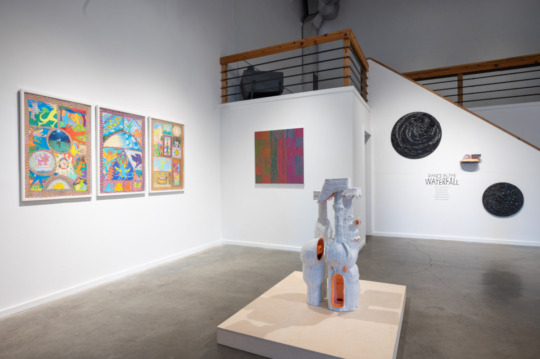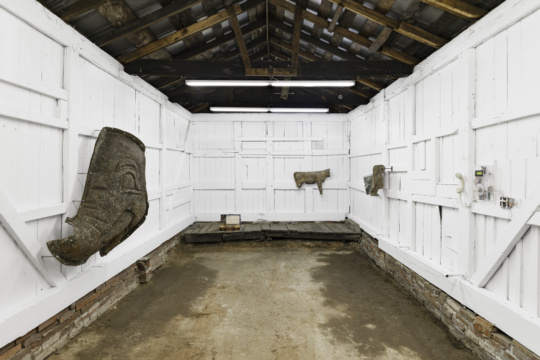
Evolutionary psychology, cognitive science, and neuroscience seem to be in the ascendant in mainstream intellectual power circles these days, to the point that the New York Times has a weekly column devoted to the topic, called “Gray Matter.” In academic circles, they seem on the verge of displacing the social constructionist models that have dominated numerous university departments ever since the 1980s. This past February, BURNAWAY’s own Theory in Studio writer, Alex Robins, introduced BURNAWAY readers to the emergent discipline of neuroesthetics—about which, more in a moment.
My personal opinion is that we need both bodies of information to make sense of how this bundle of responses we like to call a self interacts with and is shaped by other selves, and how the interactions of selves with the environment create a social order that has major consequences for how the self navigates the world and how the world itself interacts with the human species. Nature trumps culture in the end, as this year’s drought in the farm states of America reminds us, but culture is in a position to change nature in significant ways, and for the sake of our short-term and long-term survival as individuals and as a species, we had better find out why we are inclined to make the same dumb mistakes over and over again.

There are a few people who are trying to meld the two models into a comprehensive view of the human species, but for understandable reasons, most folks are just picking and choosing whichever models happen to coincide with the opinions they already hold. We are mostly recycling intellectual positions that date back to the ancient philosophers of the so-called Axial Age.
The trouble is that few of us really have the time to follow debates that so often go around in circles anyway, so we prize the occasional online or print articles that seem to break new ground. We have incomes to earn, lives to live, and a planet full of interesting things and people to interact with, and we can’t spend all our time coming up to speed on the terms of the discussion.
Artists, though, are rightly excited by the metaphoric possibilities of that discussion, as well as whatever light it might shed on the deeper dimensions of their own artmaking. One such artist recently suggested that I bring to people’s attention a newish (late 2011) book by an experimental jazz musician and professor of philosophy and music, David Rothenberg’s Survival of the Beautiful: Art, Science, and Evolution. Another friend even more recently pressed into my hands a copy of Eric R. Kandel’s The Age of Insight: The Quest to Understand the Unconscious in Art, Mind, and Brain, From Vienna 1900 to the Present Day.

The two books overlap, but not that much. The previously mentioned emerging discipline of neuroaesthetics appears in both, but Rothenberg starts from how the installation art (my description of it, not his) of Australian bowerbirds sheds light on the evolutionary uses of beauty, while Kandel starts with how the potent combination of attractive and repulsive images in the art of the era of Klimt, Kokoschka, and Schiele reflected an effort to explore the effects of unconscious motives and of our biological substrate. Kandel then moves through a history of twentieth-century art—including the Vienna-born art historians who wrote about it—and on into the discoveries of twentieth and twenty-first century psychology and neurology.
Rothenberg is fascinated by the details of nature and the people who make art about it. The aesthetics of Haeckel’s nineteenth-century scientific illustrations of evolutionary processes are of particular interest to him, as is camouflage in nature, and how artists’ interest in this natural phenomenon led to the development of specific types of wartime camouflage. He also touches on such bizarrely idiosyncratic features as the matching corkscrew shapes of male and female duck genitalia.

Rothenberg is blatantly and openly subjective in his approach: “I never quite trusted [Arthur Danto’s tendency to turn art into philosophy] for, as a philosopher, I would rather turn philosophy into art. Make it more beautiful, evocative, wandering in beauty. Less logic, more poetry. Less argument, more dance. If the book you’re reading is to work, it’s got to have some of that danger, risk, and delight.” This makes his reportage on intellectual debates easy reading without being fluff; it’s one thing to report on the debate over adaptationists’ insistence on functional reasons for every aspect of evolution, and another to quote a scientist in an actual debate: “You can’t do this! You can’t! It is completely religious, what you are doing, no better than Dawkins and Dutton drunk on adaptive explanations for everything!”
This back-and-forth is cited in pursuit of the refinement of Rothenberg’s own interests: “Looking to biology for the rules for beauty seems inherently conservative, the opposite of Duchamp and Danto, who prove that anything can be put forward as art if a sufficient number of people are game enough to talk about it…I am more interested in how art leads us to see more in the natural world around us, how it is one more part of human experience that makes the world we have evolved in seem ever more meaningful and important.”
Rothenberg ends his book with a summary of the neuroaesthetics that Semir Zeki has been developing for over twenty years, and it’s here that his book’s limits as an introduction to an enormously complex field begin to appear most clearly. He sets forth lucidly, in a handful of pages, how Zeki argues that great art is experienced as great because the brain values complexity and ambiguity—or more accurately, complexity and ambiguity stimulate a wider and more varied pattern of neurons in ways that, in Zeki’s words, “activat[e] the brain’s reward system with a certain intensity.”
Rothenberg then devotes a chapter to defending choices of his own as to which contemporary artworks, dealing with the topics he has previously discussed, might be taken as examples of “survival of the beautiful.” He suggests (an aesthetic hypothesis I have defended myself, for reasons other than his) that successful experimental art “still must grab us aesthetically before any questions it wants to raise. Engagement with art is fundamentally an engagement with beauty, even if it is strange or unfamiliar beauty.” Such beauty, he has argued throughout the book, is reflective of the implicit “way in which the vast beauty of the diversity of life has emerged without any design being behind it, but merely by the unfolding of very simple rules upon time and possibility.”
He then presents examples of artists working with this principle of emergent order (for that is the name generally given to it), and explains how their explorations depend upon beauty to sustain our initial interest. The problem is that for some readers and viewers (me at least), both the aesthetics and the way the concepts are explored by the artists that Rothenberg cites are tedious rather than beautiful, no matter how much they clarify “the fundamental physical law of pattern in nature.” Clearly, we are up against the issue of cultural and individual variability, as against the demonstrable universals of evolutionary biology and neuroaesthetics alike.
Rothenberg’s chosen approach allows him to back away from such dimensions of the topic in honest discomfort, alongside his discomfort at many aspects of the claims of neuroaesthetics. He wants to encourage both analysis and astonishment: “The world we live in is so beautiful it brings us to tears; we should not be afraid of it nor be content to blithely celebrate it.” There is immense value in beginning with—and retaining—emotional immediacy while pushing beyond blithe celebration into intellectual comprehension, but in the end the argument has to move into still deeper conceptual territory.
This is where the far more profound and illuminating book by Nobel-laureate neurologist Eric Kandel enters profitably into the discussion. Kandel deals with the world of culture more than with nature, to the point of not dealing much with the natural world except as it is filtered through culture, and culture as it is filtered through the nature of our own brains and nervous systems. There isn’t a corkscrew-shaped duck penis in sight, and the discussion of Mondrian’s early abstractions of nature and Klimt’s economically rendered landscapes does not start from the patterns on peacock tails, from which Rothenberg so intriguingly reinterprets so much of artistic practice (in a different key from previous interpretations of this much-overused example).
Kandel is also elegantly sequential and analytical where Rothenberg is breezily anecdotal. The Age of Insight is a genuinely comprehensive attempt to blend art history and brain research, without doing violence to the complexities of their interaction. Only an 82-year-old Vienna-born refugee from Hitler could have produced such a book: knowing the familiar story of Vienna 1900 (Freud and Klimt and Loos and Wittgenstein, O my) from an insider’s perspective, he mixes it adroitly with what we know about the biological underpinnings of art and their relationship to unconscious mental processes. The parallel legacies of, say, Freud and Kokoschka are not diminished when the story moves on to PET scans and neurons.
The book is filled with enough color photographs of paintings by Central European artists and captioned drawings of details of the human brain to resemble the textbook in neuroaesthetics we do not yet have. In terms of clarity, accessibility, and organization, this may be the best-yet introduction for artists and budding art historians to such topics as “The Brain’s Processing of Visual Images,” “Top-Down Control of Cognitive Emotional Information,” and “The Cognitive Unconscious and the Creative Brain”—alongside chapters on “Observation Is Also Invention: The Brain as a Creativity Machine” and “Artistic Universals and the Austrian Expressionists.” Of course, all of this comes after a fair number of chapters on the inward turn of Vienna 1900, from “Searching for Inner Meaning in Literature” to “The Depiction of Modern Women’s Sexuality in Art”—not to mention a survey chapter on “The Birth of Twentieth-Century Art” and ones on the multidisciplinary art history espoused between the wars by E. H. Gombrich and Erwin Panofsky.
All of this is set forth with charts, pictures, and clearly-written topic sentences like the ones that should have been in your introductory undergraduate textbooks, but weren’t. Kandel’s prose holds the reader’s attention as consistently as Rothenberg’s does, without resorting to the sometimes excessively facile rhetorical devices with which Rothenberg keeps his narrative moving.
There is much that could be said about the inherent limits of any book, but what Kandel fails to understand is far less significant than what he does understand, and it would require many pages to mount an adequate counter-argument to any of his theses—including the fusion of perspectives that we need but do not yet have.
This article offers insight into Dr. Jerry Cullum’s selections for the current exhibition, From Cosmology to Neurology and Back Again, on display at Whitespace Gallery through Saturday, August 4, 2012. He will be conducting a curator’s talk this evening at the gallery at 7PM.




